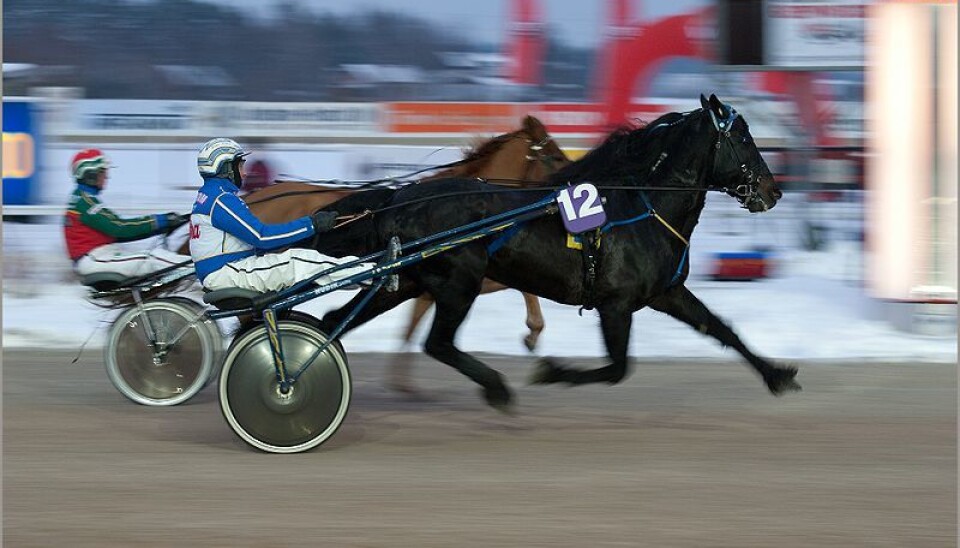An article from Norwegian University of Life Sciences (NMBU)

Help for trotters with breathing difficulties
Some trotting horses become severely short of breath during the race. Until now, the underlying causes have been poorly understood.
Denne artikkelen er over ti år gammel og kan inneholde utdatert informasjon.
Over half of all the horses in Norway are trotter racehorses and over 500 racing events are held each year.
But some of the trotters trained for use in harness racing have respiratory problems. This disorder is called dynamic laryngeal collapse and is caused by specific anatomical conditions in the throat region.
Cathrine Fjordbakk at the Norwegian University of Life Sciences (NMBU) has made this disorder the subject of her PhD research.
The disorder, which occurs almost exclusively in cold-blooded trotters, is is recognized by performance failure and abnormal sounds emanating from the throat while the horse is racing.
Symptoms triggered by the position of the head

In horses suffering from dynamic laryngeal collapse, the respiratory tract performs normally as long as the horse has a free head. Problems arise when the horses are run "on the bit", i.e. when the horse's head is reined in so tightly that its neck is arched. Just a 12-degree change in the angle between the head and the neck is enough to trigger the symptoms.
Situations like this are unavoidable in harness racing because the driver is at times obliged to use the bit in order to steer and control the horse.
Healthy horses have no problems when being run on the bit, while horses with dynamic laryngeal collapse suffer from varying degrees of collapse in the vocal cords and cartilage in the larynx.
"Even though it is clear that the symptoms of laryngeal collapse are triggered by the position of the head, the underlying causes have not been known and we wanted to find out what they are," says Fjordbakk.
Abnormal anatomy of the larynx

Fjordbakk carried out detailed examinations of the laryngeal muscles, but found no evidence to suggest that a disease in the nerves, in the transition between nerves and muscles or in the muscles themselves was the cause of the disorder.
However, X-ray and ultrasound examinations of the laryngeal region with the horse's head in a normal position or an arched position revealed that horses with dynamic laryngeal collapse have a different anatomy of the larynx than healthy horses.
Collapse of the vocal cords and cartilage in the larynx when the neck is arched also affects the mechanics of the respiratory tract.
"By measuring the pressure in the respiratory tract in horses with the disorder while racing, we found that there is less access for air through the larynx and down into the lungs when the neck is arched compared to periods when the horses have a free head, says Fjordbakk.
"The anatomy of the larynx and how the larynx is affected by an arching of the neck are therefore key factors in determining the causes of this disorder," she continues.
Alternative diagnostic methods
Since the disorder only occurs when the horse is exerting itself, a correct diagnosis is made by means of an endoscopy of the respiratory system while the horse is running on a treadmill.
Only a small number of clinics in Norway can provide this type of treadmill examination and it is therefore likely that dynamic laryngeal collapse is underdiagnosed.
However, most horse practitioners have access to ultrasound and X-ray equipment and Fjordbakk therefore drew up protocols for ultrasound and X-ray examinations of the larynx when the horse's head is in a neutral position or when the neck is arched.
"Since conventional imaging can predict dynamic laryngeal collapse with great accuracy, this is a valuable alternative method of diagnosis for veterinarians in the field and can be used to select horses that need a referral for an endoscopy on the treadmill," says Fjordbakk.
New type of equipment
Cathrine Fjordbakk has tested the prototype for a new type of equipment whose design prevents the horse's neck from arching when running on the bit.
When using this equipment, there were fewer signs of laryngeal collapse both during endoscopic examinations of the throat and during pressure measurements of the respiratory tract when the horse was on the treadmill.
"The test results of the equipment on the treadmill were good and the equipment looks promising as a method of treatment on the racetrack," concludes Fjordbakk.
------------
Read the Norwegian version of this article at forskning.no
Translated by: Deborah Ann Arnfinsen






























